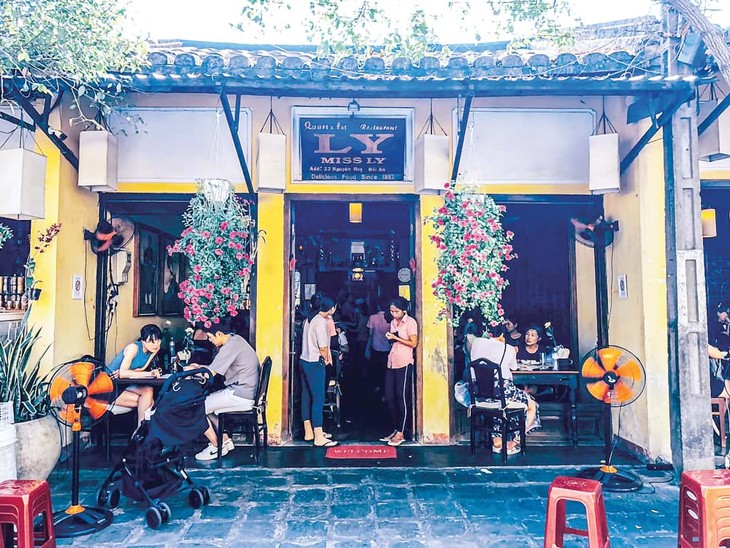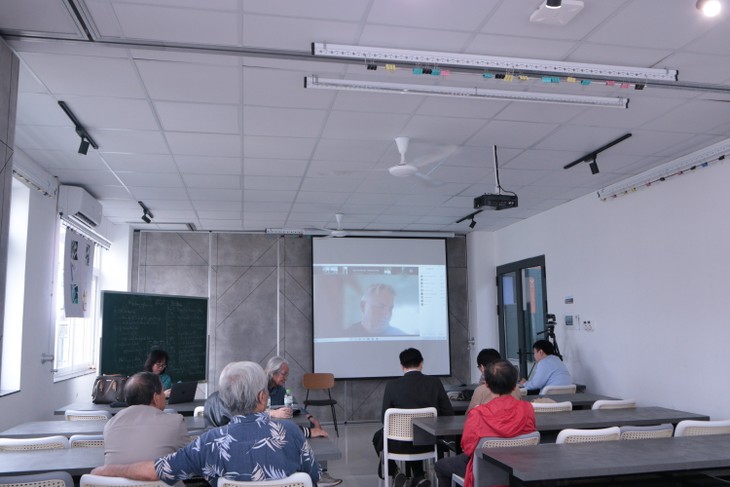(VOVWORLD) - The book “Rice talks: Food and Community in a Vietnamese Town” by Israeli anthropologist Nir Avieli takes you on a fascinating journey to explore Hoi An’s cuisine, revealing how cuisine shapes social bonds, cultural identity, and community motivation through family meals and community parties. Author Avieli shows you how food relates to class relations, gender roles, religious practices, cosmology, ethnicity, as well as local and national politics. This week’s That’s Life will describe how a person with a predestined connection with Hoi An turned his own fieldtrip experience into a thought-provoking book.
 The Caféteria Ly, the place that has inspired Nir Avieli to identify the topic for his research in Hoi An (Photo: T.A.T/Phanbook) The Caféteria Ly, the place that has inspired Nir Avieli to identify the topic for his research in Hoi An (Photo: T.A.T/Phanbook)
|
“Rice talks: Food and Community in a Vietnamese Town” was translated into Vietnamese by Pham Minh Quan and published this month by the Institute of Cultural Anthropology in collaboration with Phanbook and Da Nang Publishing House.
Nir Avieli is a senior lecturer in the Department of Sociology and Anthropology at Israel’s Ben Gurion University, and President of the Israeli Anthropological Association.
As a cultural anthropologist interested in food and tourism, Nir has been conducting research in Hoi An since 1998. He has also done field research in India, Singapore, and Thailand.
 An overview of the seminar "You know everything - but you don't understand Vietnamese people": A foreign anthropologist’s research on culinary practices in Hoi An. (Photo: Vietnam National University, Hanoi) An overview of the seminar "You know everything - but you don't understand Vietnamese people": A foreign anthropologist’s research on culinary practices in Hoi An. (Photo: Vietnam National University, Hanoi)
|
“Rice talks”, Nir said during a recent online seminar, is not just about food. It’s also about ethnic and personal culture, diachronic and contemporary culture, and local and foreign cultures.
He elaborated the reason for choosing Hoi An as a research target, “Hoi An is big enough to research complex issues. You know, the people of Hoi An are modern people. They are engaged with other countries. They are engaged with the world. They are globalized. They deal with modern problems. And Hoi An is a very complex place. In a complex place, you can ask complex questions.”
At the same time, Nir said, Hoi An is small enough to get the feeling of the city in one year.
“If you walk, đi bộ, or độp xe đạp, as we say, I could cover the town almost every day and see what's going on and get to know many people. We anthropologists always call the place where we work ‘my town’. And Hoi An is my town. If you didn't know that, I own it, it's mine,” Nir explained in details.
Another reason is that Hoi An is very complicated in its food and its long history, according to the author. Several ethnic groups have left their mark on the city, and there are enough people with enough knowledge and with enough money to create a very lively food scene, said Nir.
“Because tourists from many places are making demands, Hoi An people’s have to deal with them,” said Nir, adding, “If you want to think about modern food, about contemporary food, and not about something in the past, you know, when you lived in a village and you ate the food of the village and you never had anything else…if you want to study something complicated, and modern, Hoi An is the perfect place for anthropologists.”
The ethnographic data presented in the book are the output of a project Nir began in 1998. After 12 months of fieldwork from 1999 to 2000 to lay the foundation for the book, Nir made repeated short trips, for two or three months each time, to follow Hoi An’s ongoing development.
He recalled, “To be honest, I had no idea how to do the research, because at that time nobody was doing anthropology of food. So I decided to make for myself two rules. The first rule was to eat every meal in a different place. Breakfast here, lunch there, snack here, coffee there, dinner there, every meal in a different place.”
And this turned out to be crazy because when you go to eat, you want to relax, he admitted. “You don't want to think. But I wanted to think about the food. So I went to a restaurant for breakfast. I had to look around me and write down in my notebook how it looks, what about the menu, what about the food, try to eat something, and then go to my next place and my next place, and my next place.”
“And after two months, I had 300 ethnographic events in my notebook and I realized something about food. So this was my first theoretical insight about food,” said Nir.
“Rice Talks” explores the importance of cooking and eating in the everyday social life of Hoi An and, in a highly personal account, Nir Avieli takes readers from the private setting of the family meal into the public realm of the festive, extraordinary, and unique.
 Israeli anthropologist Nir Avieli during the online seminar (Photo: Vietnam National University, Hanoi) Israeli anthropologist Nir Avieli during the online seminar (Photo: Vietnam National University, Hanoi)
|
The conventional anthropological research on food and eating has helped Nir understand Vietnam, but Nir says readers of the book and their comments have helped him understand it more profoundly.
“I don't think anthropologists really understand people. I was in Hoi An for a long time, and I wrote about the food of Hoi An, and everything that I described in my book happened. And then I give my interpretation of what happened, and I expect the readers of the book to think about what I said and be critical of it, and present their own thoughts about my interpretation,” Nir noted.
He went on to say, “But writing the book was a long process with a lot of discussions with experts from Vietnam in anthropology. So I think I can stand firmly behind my book and say that what is written in the book are things that I have seen. My analysis has to do with a theory in anthropology that I understand, but when it comes to really understanding the people of Hoi An, I expect you to be critical of my work.”
First published by Indiana University Press in 2012, the 456-page book is an important contribution to Vietnamese anthropology given the dearth of studies on Vietnamese cuisine, especially the culinary scene of Hoi An, an ancient city that has been engaged in global trade and cultural exchange for centuries.
The book is available at bookstores nationwide and on e‑commerce websites.